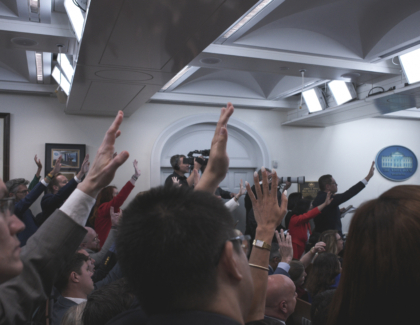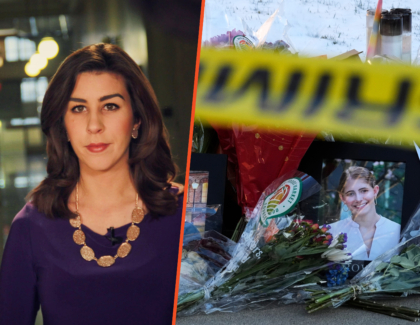Sign up for the daily CJR newsletter.
In 2019, New York City saw the launch of The City, a local nonprofit news platform built with considerable foundation and donor funding; one of the publication’s goals has been to engage with New York communities underserved by legacy media outlets. The City’s Open Newsroom initiative, a program dependent on a series of listening sessions in partnership with local libraries and community centers, plays a part in aiming to meet this goal.
Nic Dawes, The City’s executive director, spoke with CJR about the Open Newsroom, how The City imagines its audience, and the importance of integrating community engagement as a core function of a newsroom. This conversation has been edited and condensed for clarity.
How does the Open Newsroom model work, and what’s unique about it?
You know, I don’t think I’m going to claim that any single element of what we do is unique. But I think we’re bringing together a bunch of things that other people have tried in a way that really works for the New York context.
When The City was first conceived, back in 2018, when the realization started to set in that even in the media capital of the world, we were seeing really deep erosion in local reporting capacity, the first gap that people clearly saw a need to plug was coverage of city agencies and neighborhood stories that had the potential to resonate citywide. At the same time, there was an appreciation from the beginning of The City that there had been no good old days as such. There was a time when there were a lot more reporters covering New York City, but a lot of people were consistently left out of that coverage, or in some cases were framed or treated in that coverage in ways that granted them very little agency, and which reflected a pretty narrow normative framework, of relevance of values, and so on.
The Open Newsroom, from the beginning, was an attempt to ensure that we didn’t just plug gaps that had emerged in the old model, but to build a new model, one that was pretty distinct, both in its values and its audience and in the way that it went about building its coverage and agenda. When you find ways very intentionally to listen to your audience and develop journalism that’s responsive to their concerns, you actually start to think about accountability a little differently. It becomes not just a question of where can you shine the light and where can you generate impact through traditional investigative methods—although those remain critical. It can also involve really discovering the information needs of your communities, understanding where their troubles and pain points are, and speaking to elected leaders, city agencies, and other powerful actors in a way that’s informed by those inputs. And also, there’s an accountability dimension to explanatory work that emerges out of these contexts, because people who are empowered with a sense of how to navigate their city and its processes engage accordingly with those who exercise power and make choices.
That’s really the sort of guiding thread through all of this. At the outset, we started off with in-person meetings at the Red Hook Public Library or the community center in Mott Haven in the Bronx. We’d bring groups of people together for conversations, both generally on what’s going on in their world and what matters to them, and sometimes on specific topics. We had a very successful series of events on special education, for example, which also have created a network of sources and a basis for a whole range of coverage on that issue, which has, of course, been especially fraught during the pandemic. And during the pandemic, we migrated these events online, but we continued to work with community groups and libraries in order to bring in a wide array of people to these conversations.
What kind of insights emerged from these conversations?
One is that it was very quickly clear to us that people’s most urgent concerns during the pandemic were for basic information about what was going on with evictions, with rental assistance programs, and with unemployment. So we developed, essentially, news products out of those listening sessions: text messaging service, both on rental and evictions and on jobs. Jobs and housing came up as the two most urgent concerns in the meetings we conducted during the pandemic. And while a good few thousand people signed up for the emails and text messages, what was really striking was that those explainers and news updates found—by far—the largest search audience of anything on the site.
So clearly what was happening in these relatively small off-the-record conversations: the questions that were getting asked there were the ones that people were also asking to a search engine, and that were resonating much more widely. And we found something similar happened when we started conducting Open Newsrooms around New York’s huge, complex, sprawling citywide election. We held these various conversations that started very open-ended: Who’s powerful in your neighborhood? Whom do you yell at when you have a problem? How do you get results? And then delved into things like the technicalities of ranked-choice voting and so on. We developed another newsletter and a whole set of explainers off the back of those conversations, which again found a much bigger audience through search than just about anything else we do. We actually ended up creating a new staff role focused on producing stories that help people to navigate the complexities of New York life.
In the new year, we hope to have some kind of regular open-ended sessions in a range of different neighborhoods across New York, primarily choosing neighborhoods which are less covered and less likely to have access.
How do you measure that?
Well, actually, someone’s created an open-source coverage map of New York. You can see which neighborhoods get the most mentions. It’s a scraping tool. And we can argue about whether it’s accurate or not, but it’ll confirm the basic impression that brownstone Brooklyn and Manhattan below the park get a lot more coverage than outer boroughs, generally, and particularly the lower-income, less English-language-speaking parts of the city.
How does your partnership with libraries and community centers work?
We started with the Brooklyn Public Library, which has many, many branches and an incredibly smart strategic outreach team. And we formed a really good relationship with them. They have some convening power, and they have great spaces. And that relationship really developed and deepened further, during the pandemic, and we launched our largest and most complex Open Newsroom project, called Missing Them, which grew out of the insight that almost all the people who are getting obituaries early in the pandemic were white, often male, affluent. Missing Them was an attempt to memorialize every New Yorker who’d been lost to covid-19 in a more equitable way. So we asked people to send in requests for obituaries, and we assembled a team of volunteer editors, journalists, students, and others to create the obituaries with input from the families. It ended up sparking several investigative stories, and we built a kind of online memorial. And then with the Brooklyn Public Library, we did a couple of virtual memorial events where we brought people together, had poetry and music. Brian Lehrer did an amazing show where his listeners read out all of the names on our list over the course of the show, an incredibly powerful thing.
That was probably the kind of high-water mark of our collaboration with the library. But the library is very thoughtful about community information needs. They are really open to partnership. And we found a really strong, clear, obvious alignment [with] our mission to serve people relevant information. In the run-up to the election, we did multiple events with libraries. We provided voter guides, we had people on hand to explain ranked-choice voting, to walk people through how to think about the different council candidates, the various other elected officers, public advocate, and so on, in addition to the mayoral race. Libraries also see the kind of two-way exchange, the conversation about what community information needs are and the attempt to build meaningful response to that, as very closely aligned with what they’re trying to achieve. So it’s just a really natural fit. And if you can, if we can triangulate it a little bit with community groups as well who are able to bring people along who might not otherwise hear about the different work from the library. That just enriches the conversation on one level.
I’m thinking through how newsrooms think about the idea of a reader or an audience and it strikes me that often there’s this one-to-one idea: I have a reader in mind, and this reader always reads me. But it strikes me that some of what you’re describing is a little different from that, right?
Very much. We are doing work at the moment to be more thoughtful about the different types of readers whom we have, when we meet them, where we meet them, and how we can do things that are useful and relevant to them. One of the things that strikes us coming out of that research is that we have a very diverse coalition of readers. Some of them are people who subscribe to our general newsletter and come to us pretty much every day. Maybe small-dollar donors are people who see themselves as deeply involved in the civic life of the city, and who identify with investigative journalism, also our explanatory and political reporting, and who derive some sense of their own agency from their knowledge of what’s going on in city government and city politics and civic affairs. We have a lot of other readers who come to us because they have urgent and specific problems that they need to address.
Someone who comes to us to find out about how to deal with a looming eviction has a very different set of needs. Or someone who comes to us because they weren’t able to afford to place an obituary in a mainstream paper. And we want to be able to serve both.
And you could say, on one model—I’m presenting sort of two extreme ends of the spectrum here—one is a relatively affluent, highly media-savvy group of people who’ve been frustrated that they don’t have good local news. And now they come to us to get it. And the other is a group of people who are economically vulnerable, often marginalized to varying degrees by the media, who come to us because they have really urgent concerns that we may be able to provide information to address. Of course, there’s a huge range of people between those two poles, who may simply want to figure out how to vote someday or may want to understand why the subway that they always take to work is running slower. Or if you want to use our covid tracking tool to see what infection rates in their neighborhood, also, they can make day-to-day risk decisions. We want to be relevant across those different groups. So we don’t have a single ideal reader—we might have six different reader types whom we imagine and we need to serve in order to fulfill our mission in a city like this one.
What are your takeaways from this process, things that you have learned along the way that you think would be good for newsrooms interested in doing this sort of thing to keep front of mind?
One is that I think it’s critical to have a high degree of integration between the people who are leading the responsive journalism and everything else in the newsroom. It should be seen as a core editorial function, not a clip-on. It should inform your thinking about all your beats, it should inform your choices about your news budget. And there should be really strong processes, not just intentions for sharing information and insights and building new products that come out of this work. It should be central from both a strategy and a crunchy process perspective. The more we’ve integrated, the more impactful it’s been for us.
And the other thing I would say is sometimes I get the impression that you have one group of people that talks about audience growth and numbers and scale and another that talks about community and mission. My sense from this work is that actually a lot of our most powerful audience growth has come out of community listening. We should be putting these things together: our audience work, our product work, and our community listening work at a fundamental level.
And the last thing I would say is that I think we’ve all had a temptation, understandably, to want to be inventing the future of journalism and claiming the new thing. Or claiming to be the originators of new things. I think we’re reaching a point with a lot of this work where there’s a gathering body of expertise out there in the world. And it’s starting to be possible to build on that foundation that a lot of incredibly smart and thoughtful people have laid over the last five years at the intersection of community listening, membership work, and mission-driven journalism more broadly. I’m not at all embarrassed to say that we don’t claim to have invented any of this stuff. But we’re seeing it come together for us in ways that are customized for New York City and combined in ways that maybe you need us to draw on that growing pool of expertise. And that’s a great place to be.
The Journalism Crisis Project aims to train our focus on the present crisis, and to foster a conversation about what comes next. We hope you’ll join us. (Click to subscribe!)
EXPLORE THE TOW CENTER’S COVID-19 CUTBACK TRACKER: Over the past year and a half, researchers at the Tow Center collected reports of a wide range of cutbacks amid the pandemic. There’s an interactive map and searchable database. You can find it here.
Below, more on recent media trends and changes in newsrooms:
- 2021 SEES FEWER MEDIA CUTBACKS: Media job cuts in 2021 hit the lowest point since 2008, following all-time highs of cuts and layoffs in 2020, Axios reported, using data from outplacement firm Challenger Gray & Christmas. (For more data on media layoffs and cutbacks, see the Tow Center’s recent report on news workers laid off amid the pandemic).
- CHERRYROAD MEDIA PURCHASES ELEVEN MORE GANNETT PAPERS: New Jersey–based company CherryRoad Media now owns thirty-six papers in eight states after acquiring seven more local Gannett papers in Minnesota and four in Colorado. (ICYMI, in October, I spoke to CherryRoad CEO Jeremy Gulban and Brian Larsen, the editor of Minnesota’s Cook County News-Herald, a paper that CherryRoad acquired in 2020.) “These smaller community newspapers just need attention and focus,” Gulban told Minnesota’s Star-Tribune. “A big company like Gannett, that’s not their business. Their business is larger newspapers, and they realized that.”
- MEDIA EXPERTS CONSIDER THE STATE OF LOCAL NEWS: In a special report, Northwestern’s Local News Initiative examines the growing challenges facing local news: among them, how the loss of local news affects covid-19 coverage and climate change coverage (and vice versa). “Local news is critical to educating and inspiring policy action from news consumers where national news outlets and global perspectives on climate change can’t really get the juices going for people to care,” Rick Weiss, the founding director of SciLine, which connects journalists to information about science, told Medill’s local news project. (Elsewhere, for CJR, Andrew McCormick writes that much climate coverage fell short in 2021, but there’s hope for 2022.)
Has America ever needed a media defender more than now? Help us by joining CJR today.







